Well, hello there…long time, no talk/read/write/whatever. The entire staff of the Gazette took a lightly-deserved break for a couple of weeks to attend to pressing matters such as lying on a beach in Wailea, marveling at $22 cheeseburgers, contemplating the mystery of why there can never be more than one person working behind a car rental counter, regardless of how long the line of customers might be, and confirming the theory that one never really makes up for lost sleep from an overnight flight.
I mentioned Wailea above. I assume that some of you know that it’s a community located on the south part of the island of Maui, famous for its golf courses, beaches, resorts, $22 cheeseburgers, and tourists covered with oil. Compared to the Texas Hill Country, Maui is bereft of wildlife (Japanese tourists don’t count; those from Texas…might). During our stay we spotted a mongoose, a nēnē goose on the wing, an abundance of cattle egrets, and even more anoles seeking to avoid becoming meals for said egrets.
And speaking of egrets and anoles, we made a new friend during a stroll along the beach in Wailea, a hungry and skilled hunter who seemed to enjoy our company, although I’ve been known to overly engage in anthropomorphization.
You might not be able to discern it on the video, but the bird had a tag of some sort on its left ankle. I’m unsure as to its purpose, but if it was placed by the anole police to keep tabs on the bird…it didn’t work.
Debbie and I had another interesting encounter during our visit to Maui. I posted the following photo to Facebook, but it’s here for the benefit of those fortunate enough to not be addicted to consumers of that content.
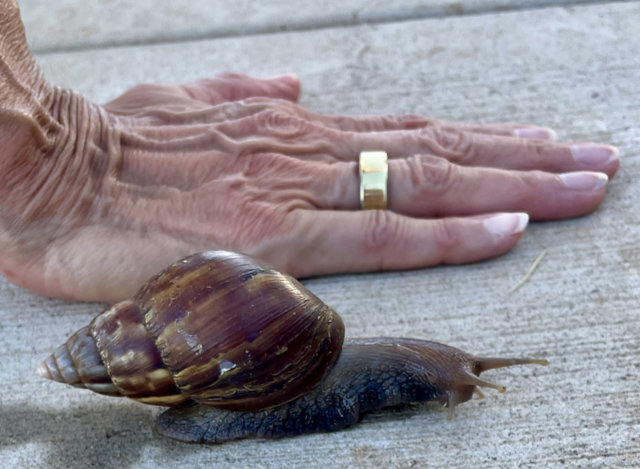
This is a Giant African Land snail (Lissachatina fulicahey ), an invasive pest introduced to Maui in 1936. They can devastate garden and crop plants, and according to the preceding link are also a potential risk to human health because they can carry a parasitic nematode that can cause meningitis. Cool. Does that escargot come with a side of vaccine?
When I posted the photo on FB, a friend posed a tongue-in-cheek question: do they bite? Even though she meant it as a joke, it caused me to run down a rabbit trail regarding snails’ teeth. As it turns out, snails do indeed have teeth, and in fact, they have more of them on a per capita basis than any other animal…up to 20,000.
I had never considered exactly how snails eat, but as it turns out (and contrary to what I told my friend), they have a mouth, jaws, and a tongue (the technical term for which is radula) paved with the aforementioned teeth. If you’re interested in learning more about snail anatomy — and I know you are — this website provides a fascinating look at all of those parts; the rows of teeth in particular are sort of frightening when viewed under a scanning electron microscope.
If all of this snail talk piques your interest, you might want to check out The Sound of a Wild Snail Eating, a short prize-winning book authored by Elisabeth Tova Bailey. I’ve not read it [yet] but by all accounts it’s an excellent treatise on the slow-moving mollusks, and much more.
Shifting gears a bit, but still focused on Maui nature, one of the most distinctive plants on the island is found at the summit of Haleakalā, the inactive volcano that rises to just over 10,000′ above sea level. The mountain is a national park, and is spectacular. Its desolate landscape is home to the Haleakalā silversword (Argyroxiphium sandwicense subsp. macrocephalum), a spiky-but-delicate looking plant that vaguely resembles a yucca and dots the mostly barren landscape.
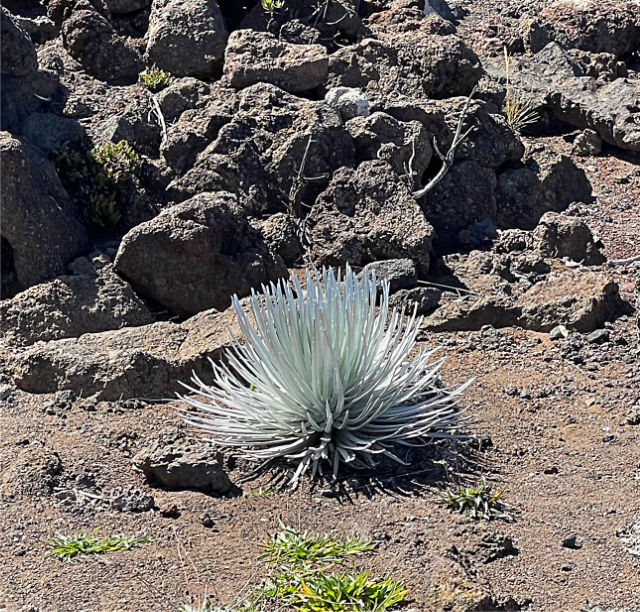
These plants have a lifespan of up to 90 years or more. Similar to the so-called Century Plant (Agave americana) and various species of yucca, they bloom once and then die so that their seeds will be scattered to procreate the species. We did not see examples of the silversword blooms during a past visit to Maui, but a number of them were on display this time.
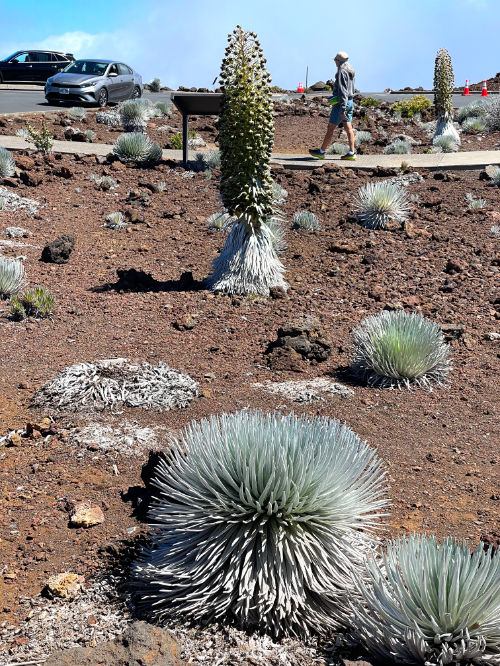
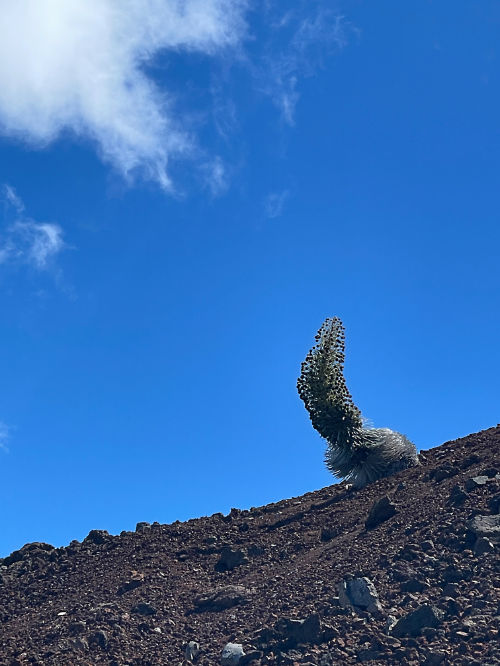
The silversword is on the protected and endangered species list, as a result of overgrazing by non-native ungulates such as Axis deer (which are a huge problem on Maui), goats, and cattle, as well as uprooting by ill-informed humans.
OK, back to the fauna of Maui. There are no native land reptiles or amphibians on the island; they have all been introduced, either accidentallly or intentionally over the years/decades (and even centuries, via Polynesian voyagers). In fact, the only native reptiles one might encounter are in the ocean: turtles and one species of sea snake. Encounters with the former are plentiful, but very rare with the latter unless you’re scuba diving far offshore (or a storm blows them closer in).
We had the pleasure of observing some green sea turtles (aka honu) sunning themselves on a rocky shore at Makena Landing Park (link opens in Google Maps). You’re almost guaranteed to see one or more on any given afternoon in that area.
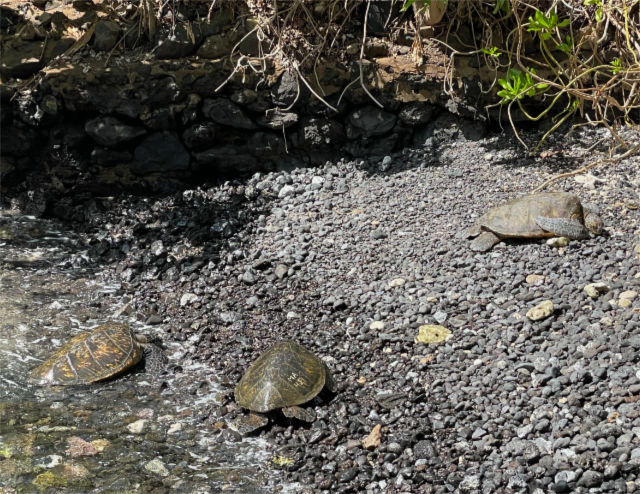
Here’s a closeup of the turtle in the middle. Note the etching on its shell.
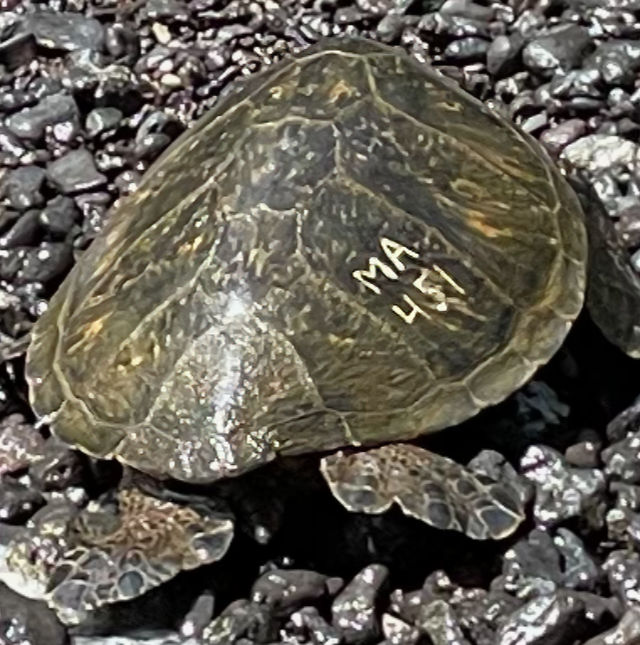
Green sea turtles are tagged with an alphanumeric “license plate number” that designates the Hawaiian island where they were first spotted (MA = Maui; HA = Hawai’i; and so on). These numbers are helpful in tracking the movements and whereabouts of individual turtles. Honu are considered an endangered species, and NOAA Fisheries has created a website whereby citizens can record sightings. (Here’s the companion site that explains the importance of such “citizen scientist” reporting.) I’ve submitted our sighting of MA451, thereby earning my Citizen Scientist merit badge, which I’ve just made up.
This wasn’t our only turtle sighting of the trip. Earlier in the week, our group was snorkeling in the shallow water in front of the Andaz resort where we were staying. My pal Sam came out of the water and motioned for me to join him in watching a turtle feeding on the algae that covered the rocks and coral just offshore. I was able to capture a short video of the event. As you can tell, the water was shallow and the surf was…active. Sorry if it’s nausea-inducing.
Did you catch the turtle getting a gulp of air at around the 35 second mark?
I think that covers our significant encounters with Maui nature, although it barely scratches the surface of the beauty of the island. It may not be a bucket list destination for you, but perhaps this will whet your appetite for an excursion. Regardless, cool stuff is happening all around you — all you have to do is look.
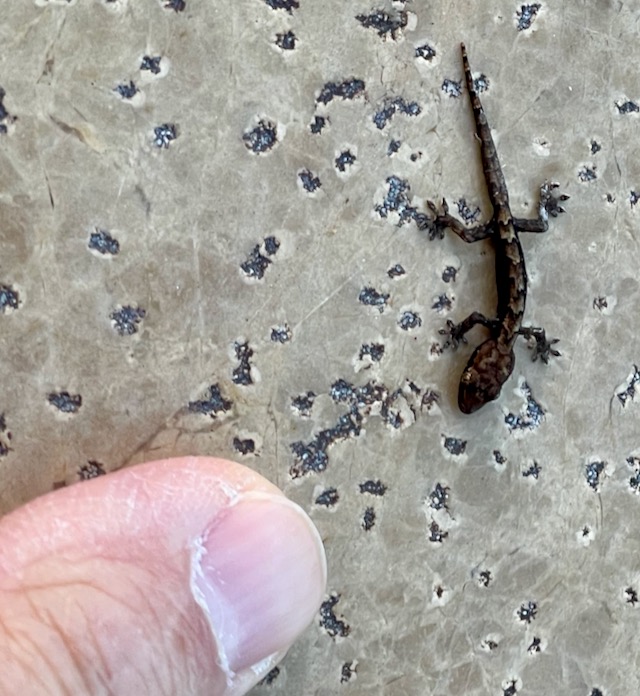
Discover more from The Fire Ant Gazette
Subscribe to get the latest posts sent to your email.

